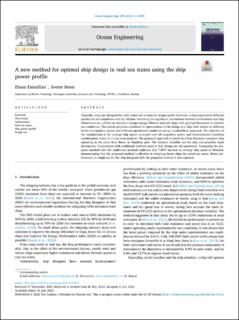| dc.contributor.author | Esmailian, Ehsan | |
| dc.contributor.author | Steen, Sverre | |
| dc.date.accessioned | 2023-02-23T13:28:41Z | |
| dc.date.available | 2023-02-23T13:28:41Z | |
| dc.date.created | 2022-07-17T13:17:08Z | |
| dc.date.issued | 2022 | |
| dc.identifier.citation | Ocean Engineering. 2022, 259 . | en_US |
| dc.identifier.issn | 0029-8018 | |
| dc.identifier.uri | https://hdl.handle.net/11250/3053646 | |
| dc.description.abstract | Typically, ships are designed for calm water and a constant design speed. However, a ship experiences different speeds and sea conditions over her lifetime. Following the significant correlations between environment and ship behavior at sea, efforts are needed to design energy-efficient and safe ships with good performances in realistic sea conditions. This article proposes a method for optimization of the design of a ship with respect to different levels of propulsive power and different operational conditions using a probabilistic approach. The objective of the optimization is the average ship speed, averaged over all propulsion power and environmental condition combinations based on a long-term analysis. The proposed approach is tested on a Post-Panamax container ship operating in the route from Busan to Hamburg port. The decision variables are the ship and propeller main dimensions. Comparisons with traditional methods used in ship design are also presented. Comparing the proposed method with the traditional methods indicates that 7.89% increase in average ship speed is obtained, demonstrating that the proposed method is effective in designing better ships for actual sea states. Better performance in rough sea for the ship designed with the proposed method is also reported. | en_US |
| dc.language.iso | eng | en_US |
| dc.publisher | Elsevier B. V. | en_US |
| dc.rights | Navngivelse 4.0 Internasjonal | * |
| dc.rights.uri | http://creativecommons.org/licenses/by/4.0/deed.no | * |
| dc.title | A new method for optimal ship design in real sea states using the ship power profile | en_US |
| dc.title.alternative | A new method for optimal ship design in real sea states using the ship power profile | en_US |
| dc.type | Peer reviewed | en_US |
| dc.type | Journal article | en_US |
| dc.description.version | publishedVersion | en_US |
| dc.source.pagenumber | 16 | en_US |
| dc.source.volume | 259 | en_US |
| dc.source.journal | Ocean Engineering | en_US |
| dc.identifier.doi | 10.1016/j.oceaneng.2022.111893 | |
| dc.identifier.cristin | 2038542 | |
| dc.relation.project | Norges forskningsråd: 237917 | en_US |
| cristin.ispublished | true | |
| cristin.fulltext | original | |
| cristin.qualitycode | 1 | |

